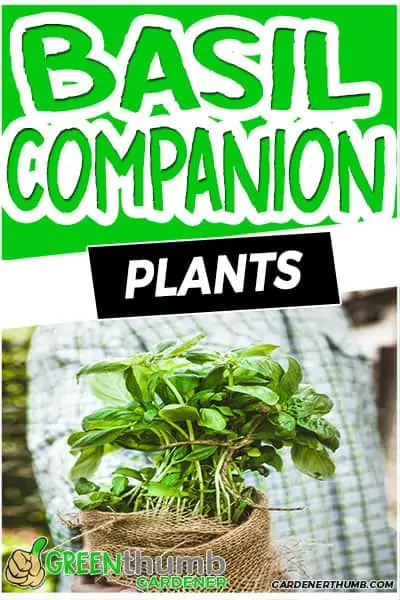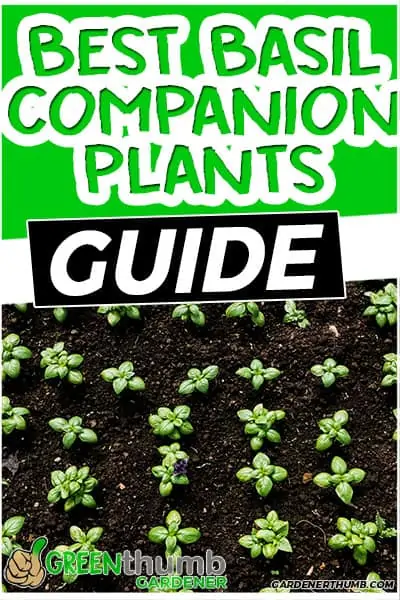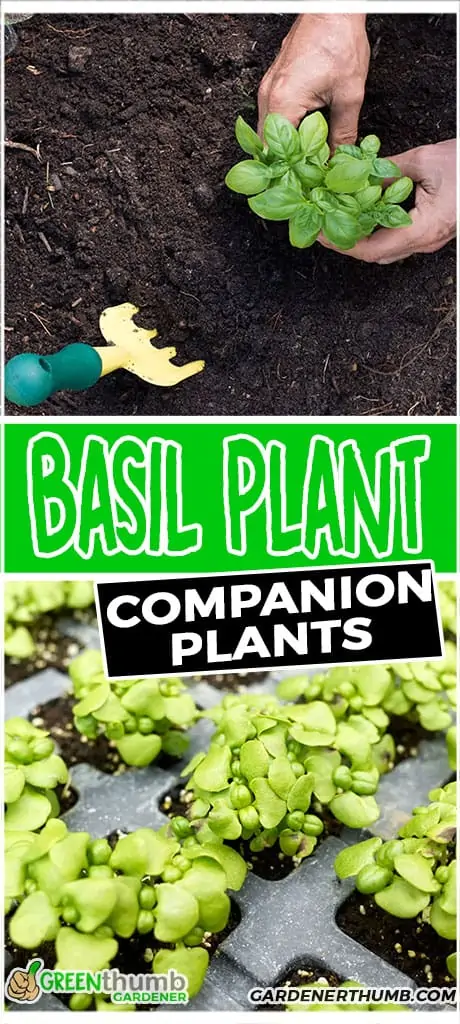Basil Companion Plants That Love Each Other
Last updated: 05/10/22
As a young gardener, I am always amazed when I learn that basil and tomatoes go together like peanut butter and jelly plus repels insect pests. Now that I am Gardener and Blogger, I know that if you want to grow basil, you also have to plant with tomatoes as it is a potent aromatic shield.
Basil is the quintessential Mediterranean flowering herb, and a staple of Italian cooking. Planting basil has been a long staple of medicinal use, and is often used as a folk remedy for the common cold.
But which plants, herbs and vegetables bring out the best in basil? Check out our list of the plants below that grow well with basil and which ones you should avoid.
Green thumb Gardener occasionally links to product and/or services offered by vendors to assist you with all your gardening needs. Some of these may be affiliate links, meaning we earn a small commission if items are purchased.
Want to Download a Garden Hack Guide for FREE

Enter your email below and we will send you a guide to help you SAVE money in your garden.
What Is Companion Planting?
We choose our friends, and people will hang around due to specific reasons. It could be their sense of humor, goodness, and kindness. For these reasons and more, we choose people that complete us.
Plants and other herbs need companions too. They need suitable companion plants like us humans do except it helps in repelling garden pests.
Plants that they can help grow and benefit from also. It is suitable for these plants to be closer to each other to enhance strength, improve soil nutrients, and boost growth.
That is what companion planting is. It is growing a family of plants that can benefit from each other next to each other.
Companion Planting works in 2 ways. Both companion plants benefit from each other equally, or one is benefiting just from the other.
Here are the two ways they work.
1. Mutualism is a relationship where both organisms benefit from each other equally. In a mutual relationship, both organisms are involved in exchanging resources such as shelter, food, or other nutrients.
They can also exchange services like protection.
For example, bush beans and corn are companion plants. The corn protects the beans, and the beans boost the nitrogen level in the soil for the corn. Cauliflower notes and spinach are also in a mutual relationship.
2. Commensalism is a relationship where one organism benefits and the other neither benefits nor gets harmed. The other organism remains unaffected. It resides like it’s invisible. No pain, No gain!
In this case, sage flowering herbs repels flies that destroy carrots but does not get any benefit from carrots. It doesn’t get harmed either. A natural insect repelling pair.

7 Benefits Of Companion Planting
Companion Planting is an easy and productive way to grow the plants in your garden, deter pests, and bring more yield.
You can use it with combinations of plants including your fruits, vegetables, flowers, and herbs. Swiss Chard, Chinese cabbage, Pole Beans, blueberry plant, & culinary herbs all have their best friend companion plant.
It will keep your garden healthy and help your plant flourish. Check out the list below for the benefits of companion planting.
1. Helps The Soil
You need to keep moist soil, boost soil nutrients, and prevent erosion with dense ground cover plants. Companion planting will help bring beneficial insects to your garden. Plants like marigolds and buckwheat also help in keeping the ground moist.
Fruits like squash and cucumber can help your soil in times of drought. Also, beans can help to restore nitrogen in your soil.
2. Provides Shelter
There are various plants you can use to protect your other plants, like offering shade for sun-sensitive plants. For instance, vegetables are driven mainly by winds.
You can plant bushes near it to prevent that. Position your corn next to your beans; it will supply nitrogen. On the other hand, corn can act as a climbing pole for your beans.
Tall plants like asparagus can help provide natural shade to your other plants and give structure to the garden, while vertical plants can help lower-growing crops like beans and peas.
3. Attracts Favorable Insects
Many companion plants planted together can attract insects that are beneficial to your garden. These plants can improve garden yield by increasing the pollinators around the park.
In our garden, we have different flowering cover crops like buckwheat that enhance pollination. Insects like butterflies, bees, and birds in your garden can also help in pollination. You can also grow plants like borage in your garden to attract beneficial insects such as ladybugs.
Plant your crops near fruit trees to attract pollinators for optimum growth and deter moths from apple trees.
4. Control of Pests and Diseases
When you position a plant that insects love with plants that they do not like, it repels them. The positioning of these plants prevents insects like carrot flies and beetles from causing any harm.
Flowers like marigolds and nasturtiums improve the growth of plants and repel pests. Nasturtiums deter squash bugs. The aroma of mint drives insects like flea beetles away.
You can plant wormwood with your cabbage to repel cabbage moths. Marigolds can be produced with beans to deter bean beetles.
You can use cauliflower patches to prevent insects like moths. Many other pests like asparagus beetle and spider mites can be deterred with fresh herbs and the right plants.
5. Supports Plant Diversity
Companion plants show how diverse various plants are and how they can still benefit from each other together as neighboring plants.
Nevertheless, some plants should never be grown with each other.
6. Encourages Productivity
Controlling pests, enhancing pollination, and saving space have become more accessible with companion planting. For instance, if you plant tomatoes, you would attract destructive insects, but if tomatoes are grown with lettuce, they protect each other.
While the lettuce deters tomato pests, tomatoes can provide shade for the lettuce. Plant sweet alyssum close to pants that have been harmed by insects like aphids before. It would help it grow.
7. Maximizes Space
If you want to have extra room in your garden, it is advisable to go for companion planting. Planting various crops together saves more space. You can produce a vining plant under a taller one.
You can also plant quick-growing crops in between slower-growing ones. Asparagus roots grow very deeply, so they can develop with shallow strawberry roots.
Companion planting will help them save space. You can produce plants like radishes with green onions to maximize space.
You can also plant tomatoes with carrots as companion plants.
Perfect Companion Plants For Basil
It is true that a basil crop is of great health benefits and can be of significant use in your garden. Some plants can enhance their services and ones that can cause harm to them.
Understanding this is important. That’s why we did in-depth research about the perfect companion plants you can grow with your basil to give you more yield.
Here are the perfect companion plants for your basil below.
Tomato
Tomato plants and basil is a great pair. Planting tomatoes and basils are an excellent combination to increase the yield and growth in your garden.
Basil plants and the balsamic aroma of their leaves can repel insects like whiteflies, mosquitoes, houseflies, tomato hornworms, fruit flies, tomato worm, and aphids from your garden.
Just like the nurse plant, basils also help to enhance the taste of the tomato in your tomato dishes.

Borage
This is great for attracting beneficial insects like bees. It can deter insects like asparagus beetles and bugs from your garden. Borage can get nutrients from the soil and supply them to basil.
Borage pairs well with Basil. It also helps in boosting the growth and taste of the basil plant. Basil can also look attractive in your delicacies if it grows with borage.
Asparagus
Asparagus and basil can bring ladybugs to your garden. The ladybugs can help to repel insects like cabbage aphids, cabbage maggot, and cabbage looper.
Basil also drives away asparagus beetles that harm the asparagus plants.
Potatoes
Potatoes grow well with basil. It is essential to choose the right fertilizer for the plants when growing them together. Potatoes take fertilizers with a high % of potassium and phosphorus, while basil take fertilizers with a high % of Nitrogen.
Regardless of this, they both complete each other’s growth. Basil also helps to drive away potato beetles with its aroma.
Chilies
This can also be called pepper. Basil enhances pepper flavor when planted with it. It can also repel certain pests such as flies and mosquitoes from your garden.
Basil hover flies can be spread on the ground, providing a ground cover for pepper. It acts as a blanket for the soil to protect pepper from direct exposure to sunlight. While basil traps heat and moisture, pepper prefers humidity.
Marigold
Both Marigold and basil are known as a pair for repelling pests. The aroma they give acts as a shield for them. They act as a trap plant and repel insects such as beet leaf hoppers, Mexican bean beetle, and branch beetle species.
Planting nearby roses can help to
Rosemary
Both basil and rosemary do well in well-drained soils. The scent of rosemary keeps insects away from your herb garden. Rosemary needs less moisture than basil.
Growing both basil and rosemary in one container is the best way to handle their growth.
Other Companion Plants
- Root vegetables like beets, summer squashes, and turnips (act as a trap crop to repel insects)
- Aromatic herbs like chives, lemon balm, lemon thyme, and Chamomile Matricaria can also complement basil plants.
As important as knowing the perfect companion plants to grow with your Basil, it is also necessary to understand the plants not being planted with your Basil.
Understanding this will help reduce your stress, frustration and make your efforts not go to waste. It will also result in optimal growth of your plants.
Avoid These Plants With Basil
- Fennel: Fennel is a growth inhibitor. It is a plant suited to grow alone. It tends to reduce the growth of crops planted with it.
- Cucumbers: The taste of basil can affect how your cucumber will taste if grown near it because cucumber is made up of water and tends to taste what is grown next.
- Rue
- Sage (Salvia Officinalis)

Further Reading
Final Thoughts
You have all the information needed to grow the right plants with your Basil. Based on individual taste and preference, you can choose the perfect companion plants for your Basil.
Regardless, tomatoes are our best choice for growing with basil. It complements basil, and basil does the same for it.
It does not have any side effects while growing with each other. Basil can enhance their taste and flavor and also repel harmful insects with their aroma. Tomatoes and Basil as companion plants are a requirement for your vegetable garden.
You can still make your final decision by checking the companion plants you feel will be the best choice for you and your garden.








